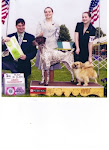By: Victoria Stilwell
 How
do you cope with a dog that is showing anxiety-based behaviors such as
aggression, inappropriate urination, guarding, destructive chewing or
barking? Know that your dog is not trying to take over your household,
even though it might seem like it.
How
do you cope with a dog that is showing anxiety-based behaviors such as
aggression, inappropriate urination, guarding, destructive chewing or
barking? Know that your dog is not trying to take over your household,
even though it might seem like it.Positive reinforcement (i.e., giving the dog a reward in the form of praise, play, food or toys when it behaves in a way that you like) has been shown to be the most effective training method for these types of behaviors. As you begin the process of modifying your dog's behavior, BE PATIENT. Positive training relies on consistency, repetition and the following general rules:
Tip #1:
First, identify WHY your dog is behaving this way. You cannot effectively deal with a behavior unless you know the root cause behind it.
Tip #2:
Once you know the WHY, then you can ask yourself HOW to treat the behavior. It is vitally important that you understand your dog. I don't believe you can train a dog well without first understanding how he perceives the world. You can then use this knowledge to make training easier.
Tip #3:
Learn to talk and think dog. Good communication increases the bond between dog and owner considerably. Dogs don't speak our human language, yet many people treat them as if they do. As a result, the dog ends up confused.
Tip #4:
 Be
kind! Never hit, scream at or yank your dog. Dogs that exhibit
aggression to humans or other dogs are under a great deal of stress,
even though they might appear confident, dominant or just plain nasty.
Think how you feel when you are fearful, angry or even violent. It is
not a good place to be. Don't combat fear with more fear – recognize
your dog's concerns, then slowly and gently teach him to overcome them.
Be
kind! Never hit, scream at or yank your dog. Dogs that exhibit
aggression to humans or other dogs are under a great deal of stress,
even though they might appear confident, dominant or just plain nasty.
Think how you feel when you are fearful, angry or even violent. It is
not a good place to be. Don't combat fear with more fear – recognize
your dog's concerns, then slowly and gently teach him to overcome them. Tip #5:
Go very slowly when dealing with anxiety-related behaviors. The best way to rehabilitate an aggressive dog is to change how he perceives the stimuli that make him anxious. Do this by slowly showing your dog that the thing he fears is no longer scary. This technique is called desensitization. If your dog is guarding the couch, food bowl, or front door, show him gently that there is another way to feel that makes him happier and more confident. For example, shower him with attention when he is on the floor, and not on the couch. Show him that good things happen to him when you approach his food bowl, because it means you'll be adding more delicious food.
Teaching obedience commands is relatively easy to do, but changing a dog's negative behaviors and perceptions is not. Therefore, it's important to enlist the help of a qualified trainer, who can help tailor a treatment plan for your dog's particular problem. Avoid trainers who use harsh methods or advocate choke, prong or weighted collars. And remember, positive training equals positive results. It might take a little longer, and require more time and patience on your part, but the positive changes you'll see in your dog are worth it!
Source: http://hcasf.org/index.php/help-for-dog-owners/98-five-rules-of-positive-dog-training
 Victoria
Stilwell is the host of Animal Planet's "It's Me or the Dog." Her no
nonsense, common sense approach to dog training is both practical and
effective. It's about educating owners on how to see things from a dog's
perspective and use positive reinforcement to encourage good behavior.
With a little patience and effort, anyone can live happily with their
canine companions. Visit Victoria Stilwell on the Web, get her training
tips and watch full episodes of "It's Me or the Dog" by clicking http://animal.discovery.com/tv/its-me-or-dog/index.html or http://www.victoriastilwell.com.
Victoria
Stilwell is the host of Animal Planet's "It's Me or the Dog." Her no
nonsense, common sense approach to dog training is both practical and
effective. It's about educating owners on how to see things from a dog's
perspective and use positive reinforcement to encourage good behavior.
With a little patience and effort, anyone can live happily with their
canine companions. Visit Victoria Stilwell on the Web, get her training
tips and watch full episodes of "It's Me or the Dog" by clicking http://animal.discovery.com/tv/its-me-or-dog/index.html or http://www.victoriastilwell.com.
No comments:
Post a Comment